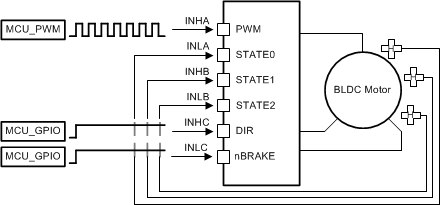SLVAES1A June 2020 – May 2022 DRV8300
- Trademarks
- 1Motor Considerations and Why Brushless DC Motors?
- 2Motor Driver Architecture
- 3Texas Instruments' Brushless-DC Motor Drivers
- 4Conclusion
- 5Revision History
2.4.1 Sensored
Sensored solutions incorporate the use of encoders, resolvers, or Hall-effect sensors to detect the position of the rotor relative to the stator at all times for proper commutation. A popular solution is Hall-effect sensors, which detect magnetic fields of the permanent rotor magnet and translate the changing magnetic fields into logic-level signals. These signals can be used as direct inputs into the motor driver or MCU to efficiently commutate the motor driver (Figure 2-6).
Speed, torque, and position applications can all use sensored solutions.
 Figure 2-6 Determining Motor Position Using Hall Effect Sensors
Figure 2-6 Determining Motor Position Using Hall Effect Sensors